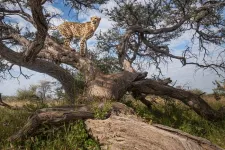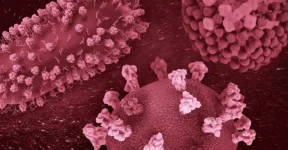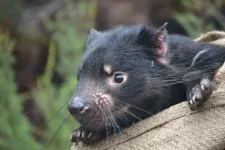(Press-News.org) A decade’s worth of research at oil and gas operations in the central and eastern United States has confirmed that fluid injection from hydraulic fracturing and wastewater disposal can induce seismicity.
Now, data from hydraulic fracturing wells in eastern Ohio indicate that extraction activities also can influence the seismicity rate, according to a presentation at the Seismological Society of America (SSA)’s 2023 Annual Meeting.
During hydraulic fracturing, well operators inject a pressurized liquid into a rock layer after drilling vertically and often horizontally through the rock. The liquid breaks apart—fractures–the rock layer and allows natural gas or petroleum to flow out more freely. This process can induce seismic activity large enough for people to feel, possibly by increasing fluid pressures within the rock that helps to unlock faults and allow them to slip.
When seismologists detected a flurry of seismicity last fall in eastern Ohio, however, there was no clear link to injection, said Michael Brudzinski of Miami University.
“The amount of seismicity kind of looked like patterns we would see when an injection operation was ongoing,” he explained. “However, when we asked the regulator what kind of activities were going on, he shared with us that there wasn’t anything new going on.”
Puzzled, Brudzinski and his colleagues began to look for other well processes that might influence seismicity. One idea they had was that “fluctuations in the amount of extraction from the reservoir might be influencing when seismicity is occurring,” said Brudzinski.
Because fracturing is so pervasive in newer wells, he explained, the amount of oil and gas that can be extracted “is large initially but it diminishes fairly quickly. So sometimes operators will stop extracting for a month or two, then start it up again, and when they start it up again it tends to produce a little bit better.”
Comparing seismic data to publicly available oil and gas operations records for the Ohio wells, the researchers saw that the unusual change in seismicity rates was associated with this “charge-up” process.
“When a particular well was temporarily halted in terms of their extraction, that’s when we see an increase in seismicity afterward,” said Brudzinski.
The researchers also noted an increase in the seismicity rate accompanying initial flowback, when liquid injected for fracturing makes its way back up to the surface when extraction starts after the fracturing process.
Extraction-related seismicity isn’t a new finding, Brudzinski said, noting studies of extraction earthquakes at the Groningen gas field in the Netherlands as one example.
“But what’s new for us is that we were not really thinking about the extraction process having an influence on seismicity in these cases where injection has been the primary cause of seismicity,” he said.
The earthquakes induced by extraction activities in this region are magnitude 2.6 or smaller—large enough to be felt but not damaging. The magnitude distribution of extraction-related earthquakes is similar to the distribution of earthquakes occurring when the wells were initially fractured.
This was surprising to Brudzinski and colleagues, who thought the extraction earthquakes might be smaller. But it suggests that the same fault activated in fracturing might be activated again during extraction, he said.
The flurry of extraction-related seismicity only lasts for a few days, and then decays over one to two weeks, compared to the several weeks to months of injection and accompanying seismic activity.
One of the bigger questions Brudzinski and his colleagues want to answer is whether they’ve discovered a unique situation in eastern Ohio, or whether extraction influencing seismicity rates is a more widespread phenomenon.
In other parts of the country where the scale of both fracturing and wastewater disposal is much larger, he said, it could be hard to detect this seismic signal of extraction.
“If we found that a few percent of the time they shut in wells and start them up again, and there’s an increase in seismicity, that would sort of suggest to me that we do need to look even in places where there’s more prevalent injection just to see if we can pick that signal up even in those places,” Brudzinski said.
END
Extraction influences seismicity at some hydraulic fracturing sites in Ohio
2023-04-20
ELSE PRESS RELEASES FROM THIS DATE:
Cheetahs need more space: Reintroduction in India must consider their spatial ecology
2023-04-20
In autumn 2022 and winter 2023, a total of 20 cheetahs from Namibia and South Africa were introduced to Kuno National Park in India to establish a free-ranging population – for the first time since their extinction in India 70 years ago. Although the idea may be commendable, getting it right is not so easy. Scientists of the Cheetah Research Project of Leibniz-IZW in Namibia see shortcomings in the reintroduction plan: In southern Africa, cheetahs live in a stable socio-spatial system with widely spread territories and densities ...
From pathogens to fads: Interacting contagions
2023-04-20
APRIL 20, 2023
Most people think of a disease outbreak when they hear the word “contagion.” But it’s a concept that extends beyond pathogens. It could be an infectious disease, a fad, an online meme, or even a positive behavior in a population.
“From the mathematical perspective, a contagion is just a thing that spreads,” says Laurent Hébert-Dufresne, a former SFI Postdoctoral Fellow, now an associate professor in computer science at the University of Vermont.
April 19–21, Hébert-Dufresne and Juniper Lovato, ...
Beaver ponds with deeper sediments store more nitrogen, simple mapping reveals
2023-04-20
American Geophysical Union
20 April 2023
AGU Release No. 23-18
For Immediate Release
This press release and accompanying multimedia are available online at:
https://news.agu.org/press-release/beaver-ponds-with-more-sediments-store-more-nitrogen-simple-mapping-reveals/
Beaver ponds with deeper sediments store more nitrogen, simple mapping reveals
Simple mapping of beaver ponds can help land managers and conservationists in the West detect which ponds are sponging up nitrogen and which are releasing it
AGU press contact:
Rebecca Dzombak, +1 (202) 777-7492, news@agu.org (UTC-4 hours)
Contact information for the researchers:
Desneiges ...
New drug may help prevent migraine for difficult cases
2023-04-20
EMBARGOED FOR RELEASE UNTIL 4 P.M. ET, THURSDAY, APRIL 20, 2023
MINNEAPOLIS – The drug atogepant may help prevent migraines for people who have had no success with other preventive drugs, according to a preliminary study released April 20, 2023, which will be presented at the American Academy of Neurology’s 75th Annual Meeting being held in person in Boston and live online from April 22-27, 2023. The study involved people with episodic migraine, which is defined as having up to 14 headache days per month with migraine ...
ChatGPT is still no match for humans when it comes to accounting
2023-04-20
Last month, OpenAI launched its newest AI chatbot product, GPT-4. According to the folks at OpenAI, the bot, which uses machine learning to generate natural language text, passed the bar exam with a score in the 90th percentile, passed 13 of 15 AP exams and got a nearly perfect score on the GRE Verbal test.
Inquiring minds at BYU and 186 other universities wanted to know how OpenAI’s tech would fare on accounting exams. So, they put the original version, ChatGPT, to the test. The researchers ...
Researchers reveal a map to study novel form of cell-to-cell communication
2023-04-20
An international team led by researchers at Baylor College of Medicine with the National Institutes of Health Extracellular RNA Communication Consortium and the Bogdan Mateescu laboratory at the ETH Zürich and University of Zürich has developed a new powerful resource to study extracellular RNA (exRNA), a novel form of cell-to-cell communication. The study, published in the journal Cell Genomics, lays the foundation to examine how exRNA and its carrier proteins found in bodily fluids function in a healthy as well as a diseased setting, potentially providing a means to accurately implement early ...
ORNL’s Lupini elected fellow of the Microscopy Society of America
2023-04-20
Andrew Lupini, a scientist and inventor at the Department of Energy’s Oak Ridge National Laboratory, has been elected Fellow of the Microscopy Society of America.
MSA fellows are senior distinguished members who have made significant contributions to the advancement of microscopy and microanalysis through scientific achievement and service to the scientific community and the society. Lupini was one of only four scientists named an MSA Fellow this year.
Lupini was cited “for foundational contribution of theory and practice ...
Purdue Ventures invests in antibody-based cancer therapeutics company
2023-04-20
WEST LAFAYETTE, Ind. – Purdue Ventures, which manages three funds to support Purdue University-connected startups, has invested $250,000 in TRIO Pharmaceuticals Inc., a cancer immunotherapeutics startup founded by a Purdue University biophysics and structural biology alumnus. The company’s antibody-based therapeutics strengthens the body’s defense, the immune system, to eradicate cancer.
Purdue Ventures’ investment is part of a larger $2.2 million series seed-funding ...
Jefferson Lab stays gold by staying green
2023-04-20
NEWPORT NEWS, VA – Finding ways to purchase sustainable products for the work of science has yielded another golden award. The U.S. Department of Energy's Thomas Jefferson National Accelerator Facility has been recognized with a gold-level GreenBuy Award for its purchase of environmentally friendly products in fiscal year 2022.
The GreenBuy Award Program honors DOE sites that go beyond the minimum requirements for purchasing products that are energy efficient, water efficient and recycled. Participating sites can qualify for three levels of the award: gold, silver and bronze.
“The award is to show our mindset is ...
Evolution of two contagious cancers affecting Tasmanian devils underlines unpredictability of disease threat
2023-04-20
PRESS RELEASE FROM THE UNIVERSITY OF CAMBRIDGE
EMBARGOED UNTIL 19:00 BST LONDON TIME/14:00 US EASTERN TIME THURSDAY, 20 APRIL 2023
Paper and photos available at: https://drive.google.com/drive/folders/1YaEEaTCCMRt85NXmCSpeO15YOrIRaXpO?usp=share_link
Transmissible cancers, which occur only rarely in the animal kingdom, are spread by the transfer of living cancer cells. In the case of Tasmanian devils, the cells are transferred through biting – a behaviour that is common in devils especially in fights over mates and food.
Tasmanian devils are susceptible to two fatal transmissible cancers called devil facial ...





